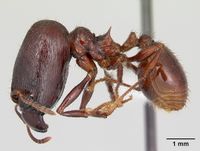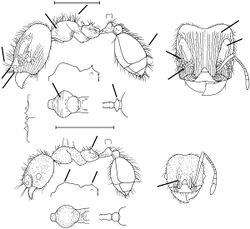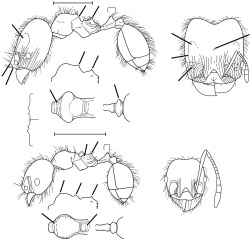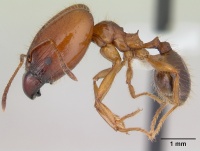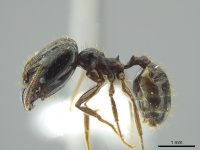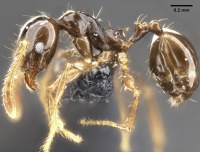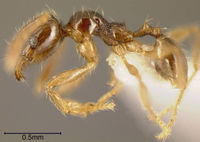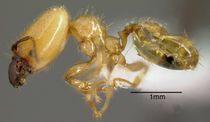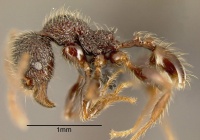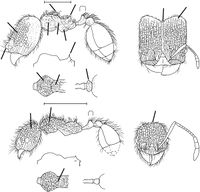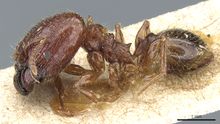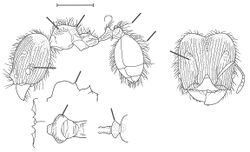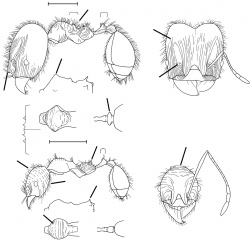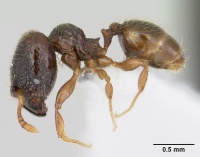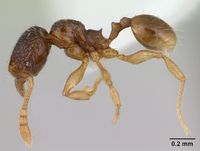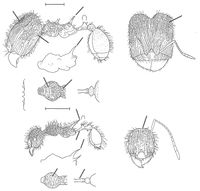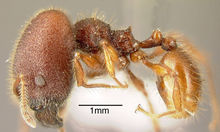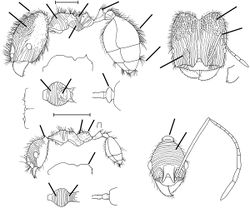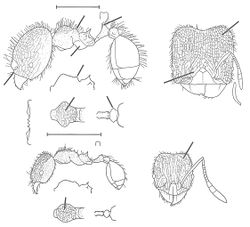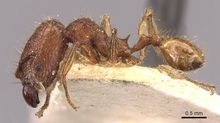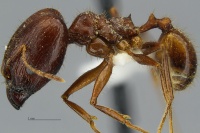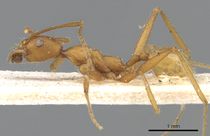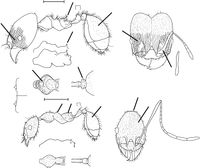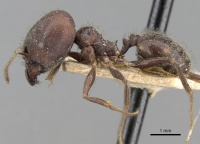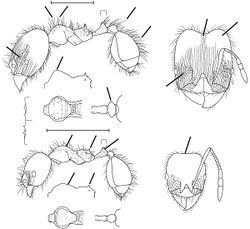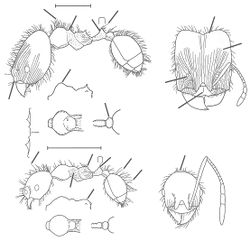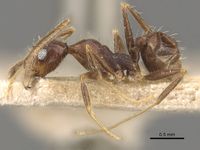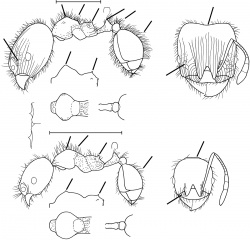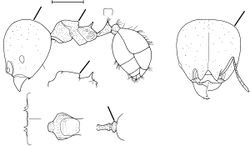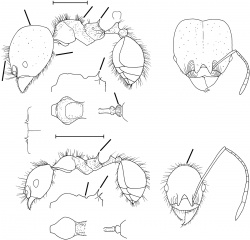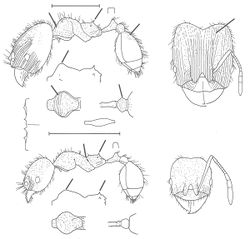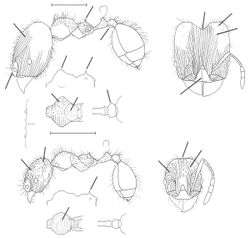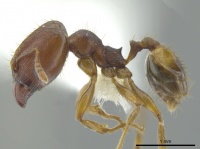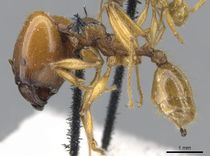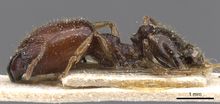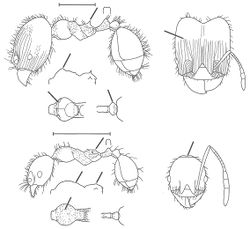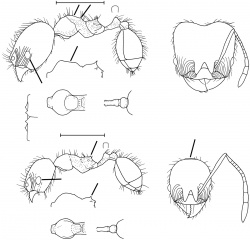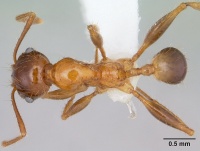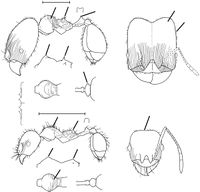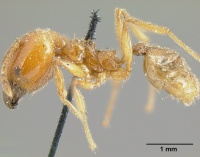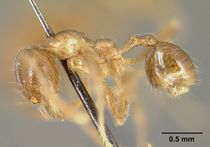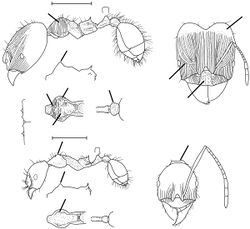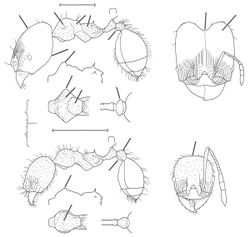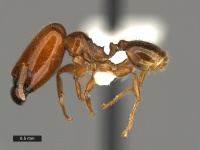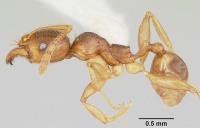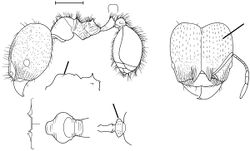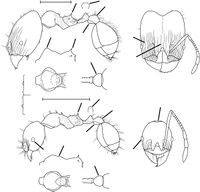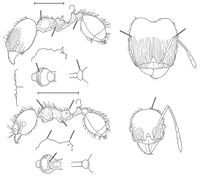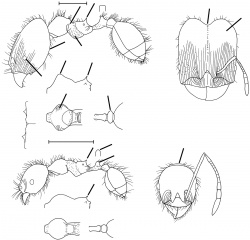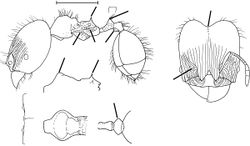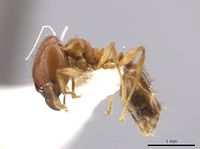Key to Pheidole tristis group
This worker key is based on: Wilson, E. O. 2003. Pheidole in the New World: A dominant, hyperdiverse ant genus. Harvard University Press, Cambridge, MA.
This exclusively Neotropical group ranges from lowland Mexico to Argentina and throughout the West Indies. It rivals the other giant Pheidole assemblages of the New World, the diligens, fallax, and flavens groups, in its species diversity and magnitude of adaptive radiation. Like these other groups, it is vaguely bounded and connected to other assemblages by phenetically intermediate species. Nonetheless, a suite of traits allows reasonably secure placement of the great majority of species classified with the Pheidole tristis group in the present treatment. They include medium to large size, 4 or 5 hypostomal teeth, comparatively short antennal scapes in the major and moderately long ones in the minor, relatively small eyes set well back from the anterior genal border, and a mesonotal convexity either weakly developed or altogether absent. Also present among a third of the species are hornlike protrusions from the frontal lobes and mid-clypeal carina in the major caste and, in many, also decoration of the pronotum with conspicuous parallel transverse carinulae in the minor caste. Three very distinctive Cuban species (Pheidole alayoi, Pheidole macromischoides, and Pheidole naylae) as well as Pheidole avia and Pheidole bucculenta from Brazil, Pheidole bruchi from Argentina, Pheidole laeviventris from Colombia, Pheidole macracantha from Panama, Pheidole severini from French Guiana, and Pheidole microps and Pheidole minax from Peru, are so far known only from minor workers and are not included in the key that follows. However, they can be readily identified from the drawings and diagnoses provided in their individual species descriptions.
You may also be interested in
1
- Very large species, Head Width of major about 2.6 mm and of minor 0.8-1.0 mm. Major: in side view, either the ventral profile of the postpetiole bulges forward to form a convexity (separate from the rest of the postpetiolar sternite) as large as the petiolar node, or else the ventral profile is covered with a dense brush of medium-length hairs . . . . . 2
- Smaller species, Head Width of major usually under 2.0 mm and rarely over 2.5 mm. Major: ventral profile of postpetiole concave, straight, or convex, but if convex, the protrusion is much smaller than the postpetiolar node, and at most it bears 3 or 4 hairs . . . . . 3
2
return to couplet #1
- Major: profile of postpetiolar venter bearing a dense brush of medium-length hairs, and profile of petiolar venter completely lined with a dense row of uniformly short hairs; postpetiolar venter bearing convexity much smaller than the petiolar node; seen from above, lateral margins of postpetiolar node drawn into spines (southern Mexico to Argentina) . . . . . Pheidole fimbriata
 Pheidole fimbriata, Major |
- Major: postpetiolar and petiolar venters at most with several hairs; and the profile of the postpetiolar venter bulges forward as a convexity as large as the petiolar node; seen from above, lateral margins of postpetiolar node smoothly rounded (southern Mexico to Amazonian Bolivia and Brazil and east to the Guianas and Tobago) . . . . . Pheidole cephalica (=Pheidole vorax)
 Pheidole vorax, Minor |
3
return to couplet #1
- Major: in side view, profile of mid-clypeal longitudinal carina drawn out from the surface of the head into a lobe, angle, or spike, sometimes small but still conspicuous; or else the frontal lobe is drawn out in profile forward or downward to create a horn, tooth, or lobe whose upper margin and lower margin if extended as lines that meet would form a right angle or acute angle; or both . . . . . 4
- Major: in side view, neither the mid-clypeal carina (if there is one) nor the frontal lobe is drawn out into protrusions as described above; in particular, even if the frontal lobe is drawn out in a short lobe, its upper margin and lower margin if extended as lines would meet to form an obtuse angle, not a right or acute angle . . . . . 40
4
return to couplet #3
- Major: the profile of the mid-clypeal longitudinal carina (as opposed to the frontal lobes) drawn outward into at least a small protruding hornlike angle, lobe, or spike . . . . . 5
- Major: the mid-clypeal profile, even if a longitudinal carina is present, is flat or slightly convex, with no part of it drawn outward as an angle, lobe, or spike (but the frontal lobes are extended this way) . . . . . 18
5
return to couplet #4
- Major: entire dorsum of head and mesosoma (thorax plus propodeum) covered by mostly transverse carinulae . . . . . 6
- Major: posterior half of dorsal head surface and at least the center of the promesonotal dorsum smooth, or foveolate and opaque, or partly covered by longitudinal (not transverse) carinulae . . . . . 7
6
return to couplet #5
- Major: in profile, the entire clypeus bulges out into a nose-like protrusion larger than the eye; in full-face view, longitudinal carinulae originating on the frontal lobes tum away from the midline of the head just anterior to the occiput and travel horizontally to the margins of the head (Amazonian Peru) . . . . . Pheidole nasifera
- Major: in profile, the posterior half of the mid-clypeal carina protrudes as a blunt obtuse angle much smaller than the eye; all carinulae on the dorsal surface of the head posterior to the eyes are horizontal (Veracruz, Mexico) . . . . . Pheidole triumbonata (=Pheidole walkeri)
 Pheidole walkeri, Major |
7
return to couplet #5
- Major: shallow antennal scrobes present, even if each is represented only by a clear or foveolate space marked posteriorly with a curving posterior carinula . . . . . 8
- Major: antennal scrobes absent . . . . . 11
8
return to couplet #7
- Major: carinulae and/or rugulae cover all of posterior half of dorsal head surface except occiput . . . . . 9
- Major: carinulae and/or rugulae absent from posterior half of dorsal head surface, with the exception of a single curving carinula that marks the posterior limit of the antennal scrobe on each side . . . . . 10
9
return to couplet #8
- Major: lateral anterior margins of mesonotum and dorsal anterior sides of propodeum carinulate. Minor: occiput rugoreticulate (Argentina, southern Brazil) . . . . . Pheidole risii (in part - also #68)
 Pheidole risii, Major |
- Major: lateral anterior margins of mesonotum and dorsal anterior sides of propodeum lack carinulae. Minor: occiput foveolate only, lacking rugoreticulum or other sculpture (Argentina) . . . . . Pheidole rosula (in part - also #68)
10
return to couplet #8
- Major: in side view, margin of mesonotal convexity as high as pronotal margin; anterior pronotal strip with multiple carinulae; median ocellus present. Minor: nuchal collar absent (Venezuela) . . . . . Pheidole gravida
- Major: in side view, margin of mesonotal convexity much lower than pronotal margin; anterior pronotal strip with only a single carinula; ocelli absent. Minor: nuchal collar present (Venezuela) . . . . . Pheidole rhytifera
11
return to couplet #7
- Major: in full-face view, frontal lobes square in shape, completely smooth and shining, and the distance between their outer margins 2 X as great as the distance from the outer margin of either one to the nearby lateral margin of the head (Costa Rica, Colombia) . . . . . Pheidole vallifica
 Pheidole vallifica, Major |
- Major: in full-face view, the frontal lobes are lobe-shaped or angular in front, not square-shaped, and they are at least partly covered by longitudinal carinulae . . . . . 12
12
return to couplet #11
- Major: in side view, center of clypeus extended as a large nose-like lobe longer than the eye, and its visible part is rugoreticulate (Choco, Colombia) . . . . . Pheidole binasifera
 Pheidole binasifera, Major |
- Major: in side view, the protrusion of the clypeus either is much smaller than the eye or, if as large, the visible part is not rugoreticulate . . . . . 13
13
return to couplet #12
- Major (possibly the ant species of any genus with the most elaborate cephalic armament): the anterior clypeal margin is extended downward as 4 large teeth, one pair to a side; the center of the clypeus (viewed from the side) protrudes as a nose-like appendage larger than the eye; a sharp spike projects from the uppermost margin at the center of the clypeus; and the frontal lobes project outward somewhat as additional lobes (montane Colombia) . . . . . Pheidole mirabilis
- Major: in side view, bearing only a comparatively small central projection on the clypeus and, in some species, a projection of the frontal lobe . . . . . 14
14
return to couplet #13
- Major: the space between eye and antennal fossa is at least partly filled by rugoreticulum (Central America, Colombia) . . . . . Pheidole rhinoceros
 Pheidole rhinoceros, Major |
- Major: the space between eye and antennal fossa is entirely filled by longitudinal carinulae, and lacks a rugoreticulum . . . . . 15
15
return to couplet #14
- Major: strong parallel transverse carinulae cover the anterior third of the pronotal dorsum and all of the basal face of the propodeum (montane Colombia and Ecuador) . . . . . Pheidole unicornis
- Major: at most, several broken transverse carinulae occur on the anterior third of the pronotal dorsum; carinulae absent from the basal face of the propodeum . . . . . 16
16
return to couplet #15
- Major: in side view, profile of mesonotal convexity is triangular with an acute apex. Minor: seen from above and obliquely, propodeal spine reduced to an obtuse angle formed by the two propodeal faces (Bolivia, Costa Rica) . . . . . Pheidole cornicula
 Pheidole cornicula, Major |
- Major: in side view, profile of mesonotal convexity surmounted by at most a low secondary convexity. Minor: seen from above and obliquely, propodeal spine developed at least as a well-formed triangular denticle . . . . . 17
17
return to couplet #16
- Major: moderately large species (Head Width of major l.9-2.0 mm, of minor 0.6 0.7 mm); in side view, propodeal spine rises perpendicular to the basal face of the propodeum and is half as long; mesonotum foveolate and opaque. Minor: dorsal surface of head foveolate and opaque (Argentina, southern Brazil) . . . . . Pheidole schwarzmaieri
- Major: smaller species (Head Width of major about 1.5 mm, of minor 0.6 mm); in side view, propodeal spine forms a l30-degree angle with the propodeal basal face and is only one-third as long. Minor: dorsal surface of head smooth and shiny (Costa Rica, Nicaragua) . . . . . Pheidole celaena
 Pheidole celaena, Major |
18
return to couplet #4
- Major: head completely lacks rugoreticulum; its sculpture is limited to carinulae and foveolae . . . . . 19
- Major: head with at least small patches of rugoreticulum, especially laterad to or behind the antennal fossae . . . . . 26
19
return to couplet #18
- Major: in full-face view, longitudinal carinulae on both sides of the midline extend posteriorly all the way to the occipital border. Major and minor: in side view, propodeal spine is more than half as long as the basal face of the propodeum anterior to it, and, in the minor, the spine is curved posteriorly (montane Colombia) . . . . . Pheidole pidax
- Major: in full-face view, at least the posterior third of the head capsule free of carinulae, and smooth and shining. Major and minor: in side view, propodeal spine less than half as long as the basal face of the propodeum, and straight, not curved posteriorly . . . . . 20
20
return to couplet #19
- Major: propodeal spiracle nearly half as wide as length of the eye and also as wide as base of propodeal spine; seen from above and obliquely, humerus subangulate; head capsule bicolored, with anterior half yellow and posterior half yellowish brown. Minor: in side view, propodeal spine one-third as long as propodeal basal face and pointed backward, almost level with the face (Costa Rica to Brazil and Peru) . . . . . Pheidole cramptoni
 Pheidole cramptoni, Major |
- Major: propodeal spiracle much less than half as wide as eye length and not as wide as base of propodeal spine; seen from above and obliquely, humerus smoothly rounded; head capsule concolorous, variously yellow to brown, or, if bicolored, anterior half is dark reddish brown. Minor: in side view 5 propodeal spine either is much shorter than one-third the basal propodeal face, or, if longer, it rises nearly perpendicularly to the basal face . . . . . 21
21
return to couplet #20
- Major: seen from above, lateral margins of postpetiolar node are drawn out into sharp spines . . . . . 22
- Major: seen from above, lateral margins of postpetiolar node are right-angular or convex, not spinose . . . . . 23
22
return to couplet #21
- Major: in side view, frontal lobes extend as acute angles downward almost to the level of the anterior clypeal border (Para, Brazil) . . . . . Pheidole allarmata
 Pheidole allarmata, Major |
- Major: in side view, frontal lobes point outward, perpendicular to the head surfaces and do not approach the anterior clypeal border (Brazil) . . . . . Pheidole moseni
 Pheidole moseni, Major |
23
return to couplet #21
- Major: seen from the side, promesonotal profile as a whole forms a smooth semicircle; in side view also, frontal lobe forms a triangle whose height (away from head surface) is about equal to the width of its base along the head surface. Major and minor: body yellow (Guyana) . . . . . Pheidole synarmata
 Pheidole synarmata, Major |
- Major: seen from side, promesonotal profile bilobed or flattened, not semicircular; in side view also, frontal lobe forms a triangle only half as high as the base is wide. Major and minor: yellowish brown or dark brown . . . . . 24
24
return to couplet #23
- Major: longitudinal carinulae immediately mesad to the eye extend posteriorly to halfway between the level of the eye and level of the occipital margin; a well-defined suture extends all around the boundary between prothorax and mesothorax, and in side view it divides the promesonotal profile into 2 lobes; dorsum of head concolorous dark brown (Costa Rica) . . . . . Pheidole hasticeps
 Pheidole hasticeps, Major |
- Major: longitudinal carinulae immediately mesad to the eye extend posteriorly only one-tenth or so the distance from level of the eye to level of the occipital margin; suture separating the prothorax and mesothorax absent from the promesonotal dorsum, the profile of which is a single flattened curve; either light yellowish brown or tricolored (head brown, mesosoma and waist yellow, gaster brown) . . . . . 25
25
return to couplet #24
- Major: light yellowish brown, with a darker, indistinct brownish spot just posterior to center of the head (abundant in disturbed habitats, southern Mexico to Brazil and throughout the West Indies) . . . . . Pheidole subarmata
 Pheidole subarmata, Major |
- Major: tricolored, head medium brown, mesosoma, waist, and legs yellow, gaster light brown (montane Trinidad) . . . . . Pheidole triplex
26
return to couplet #18
- Major: posterior half of head capsule, and all of pronotal and propodeal dorsa covered by parallel transverse carinae (Costa Rica) . . . . . Pheidole arietans (=Pheidole walkeri)
 Pheidole walkeri, Major |
- Major: transverse carinulae cover at most the pronotal dorsum and/or a small part of the occiput . . . . . 27
27
return to couplet #26
- Major and minor: all of pronotal dorsum or at least its anterior half rugoreticulate . . . . . 28
- Major and minor: at most, the humeri alone are rugoreticulate in major, and pronotum dorsum of minor lacks rugoreticulum entirely . . . . . 31
28
return to couplet #27
- Major: in full-face view, posterior half of dorsal surface of head smooth and shiny (montane Venezuela) . . . . . Pheidole hortonae
 Pheidole hortonae, Major |
- Major: in full-face view, posterior half of dorsal surface of head mostly or entirely rugulose to rugoreticulate, with non-reticulate portion foveolate and opaque . . . . . 29
29
return to couplet #28
- Major: occiput and sides of pronotum entirely rugoreticulate (southeastern Brazil) . . . . . Pheidole aper
 Pheidole aper, Major |
- Major: occiput and sides of pronotum rugose or foveolate, not reticulate . . . . . 30
30
return to couplet #29
- Major: in full-face view, occiput longitudinally rugulose; sides of pronotum with scattered, broken longitudinal rugulae; anterior fringe of central strip of first gastral tergite foveolate and opaque. Minor: sides of pronotum rugoreticulate; in side view, propodeal spine perpendicular to the basal propodeal face and one-third as long (Panama, Costa Rica) . . . . . Pheidole traini
 Pheidole traini, Minor |
- Major: in full-face view, occiput foveolate and opaque, lacking rugulae and carinulae; sides of pronotum covered by widely spaced, continuous transverse rugulae; first gastral tergite entirely smooth and shiny. Minor: sides of pronotum longitudinally carinulate; in side view, propodeal spine a triangular denticle less than one-tenth as long as the basal propodeal face (Sao Paulo, Brazil) . . . . . Pheidole sigillata
 Pheidole sigillata, Major |
31
return to couplet #27
- Major: in side view, frontal lobes drawn out into forward-directed, sharp, acute angular, and upward-curving horns; seen from above and obliquely, humerus acute-angulate (Choco, Colombia) . . . . . Pheidole diabolus
 Pheidole diabolus, Major |
- Major: in side view, frontal lobes at most right-angular, round-tipped, and not curving upward; humerus smoothly rounded . . . . . 32
32
return to couplet #31
- Major: shallow antennal scrobes present and clearly demarcated by surrounding sculpture on the dorsal head surface, although not deep enough (nor are the frontal lobes expanded enough laterally) to receive the antennae . . . . . 33
- Major: at most a slight trace of antennal scrobes present . . . . . 38
33
return to couplet #32
- Major: rugoreticulum limited to a small patch between eye and antennal fossa (Santa Catarina, Brazil) . . . . . Pheidole rosae
 Pheidole rosae, Minor |
- Major: rugoreticulum present or not between eye and antennal fossa, but either way also occurs in a small patch either just posterior to the antennal scrobe, or just behind and above the eyes, or both . . . . . 34
34
return to couplet #33
- Major: in full-face view, carinulae on dorsum of head surface extend all the way to occipital border, including occipital lobes (Ecuador) . . . . . Pheidole fullerae
- Major: in full-face view, occiput lacking carinulae, its surface smooth and shiny, with or without scattered foveae . . . . . 35
35
return to couplet #34
- Major: rugoreticula present as small patches behind and above the eye and also behind the posterior margin of the scrobe (Santa Catarina, Brazil) . . . . . Pheidole hetschkoi
 Pheidole hetschkoi, Major |
- Major: rugoreticulum present either as a small patch just behind and above the eye or else as a small patch just behind the antennal scrobe, but not both . . . . . 36
36
return to couplet #35
- Major: rugoreticulum present as a small patch just behind and above the eye, but absent from just behind the posterior margin of the antennal scrobe (Ecuador) . . . . . Pheidole napoensis
- Major: the reverse of above, i.e ., rugoreticulum present as a small patch just behind the margin of the antennal scrobe but absent from behind and above the eye . . . . . 37
37
return to couplet #36
- Major: seen in dorsal-oblique view (mesosoma rotated around long axis 45 degrees from top view), profile of pronotal dorsum forms the near-perfect arc of a circle; mesonotal dorsum completely covered by transverse carinulae. Minor: entire promesonotal dorsum covered by transverse carinulae (Choco, Colombia) . . . . . Pheidole securigera
- Major: seen in dorsal-oblique view, anterior half of profile of pronotal dorsum raised as a separate lobe, and posterior half nearly flat; mesonotal dorsum mostly bare of carinulae. Minor: transverse carinulae are absent from mesonotum, and only several occur near anterior and posterior margins of pronotum (Ecuador) . . . . . Pheidole guayasana
38
return to couplet #32
- Major: rugoreticulum mesad to the eye extends posteriorly almost to the occipital border (Costa Rica) . . . . . Pheidole arachnion
 Pheidole arachnion, Major |
- Major: rugoreticulum mesad to the eye restricted to the space between the eye and the antennal fossa . . . . . 39
39
return to couplet #38
- Major: very large (Head Width 2.3 mm); reddish yellow; propodeal dorsum longitudinally carinulate; seen from above and obliquely, humerus right-angulate (southeastern Brazil, Paraguay) . . . . . Pheidole praeses
- Major: small (Head Width 0.8 mm); medium to dark brown; propodeal dorsum lacking carinulae; seen from above and obliquely, humerus smoothly and evenly rounded (Bolivia) . . . . . Pheidole mosenopsis
 Pheidole mosenopsis, Major |
40
return to couplet #3
- Major: in full-face view, entire posterior third of head, up to and including occipital lobes, rugoreticulate . . . . . 41
- Major: in full-face view, at least the occipital lobes and usually the entire posterior third of the head, variously smooth and shiny, foveolate, rugose, or carinulate, but not reticulate . . . . . 48
41
return to couplet #40
- Major and minor: in side view, propodeal spine as long as or longer than the basal face of the propodeum anterior to it; very large (Head Width of major 2.6 mm, of minor 0.9 mm). Major: entire dorsal surface of gaster foveolate and opaque (Mexico) . . . . . Pheidole ursus
 Pheidole ursus, Minor |
- Major and minor: in side view, propodeal spine only one-third as long as the propodeal basal face, or shorter; medium-sized to large (Head Width of major 1.1- 2.2 mm, of minor 0.6-0.7 mm). Major: at least the posterior three-quarters of first gastral tergite smooth and shiny . . . . . 42
42
return to couplet #41
- Major: entire mesosoma enveloped in groups of variously transverse, longitudinal, or even concentric semicircular carinulae. Minor: dorsal surfaces of head and mesosoma covered by transverse or semicircular carinulae . . . . . 43
- Major and minor: body and head mostly rugose and rugoreticulate, not enveloped by carinulae as described above . . . . . 44
43
return to couplet #42
- Major: in side view, entire area of head behind (ventral) and posterior to the eye rugoreticulate. Minor: propodeal spine present; nuchal collar (behind occiput) absent (Costa Rica to Ecuador) . . . . . Pheidole ectatommoides
 Pheidole ectatommoides, Major |
- Major: in side view, almost all of the area of head behind (ventral) and posterior to the eye smooth and shining, bearing only a few longitudinal carinulae. Minor: propodeal spines absent; nuchal collar present (Choco, Colombia) (placed in the fallax group; also keyed out here to ensure identification) . . . . . Pheidole tigris
44
return to couplet #42
- Major: in full-face view, head capsule square; long axes of the frontal lobes pointed away from each other at right angles and in the direction of the anterior corners of the head (montane Atlantic forest, Brazil) . . . . . Pheidole dyctiota
- Major: in full-face view, head subrectangular or else somewhat heart-shaped; long axes of frontal lobes are approximately parallel and point forward toward the middle of the anterior clypeal border . . . . . 45
45
return to couplet #44
- Major: dorsal surface of head capsule entirely rugoreticulate, except for antennal fossae, clypeus, and frontal triangle. Minor: in side view, anterior portion of basal face of propodeum drops precipitously through a right angle followed by steeply vertical descent to the metanotal groove (Sao Paulo, Brazil) . . . . . Pheidole lutzi
 Pheidole lutzi, Major |
- Major: frontal lobes lack rugoreticulum; they are covered instead by parallel longitudinal carinulae or rugulae. Minor: basal face of propodeum descends anteriorly to the metanotal groove through an even convexity followed by a gently oblique slope . . . . . 46
46
return to couplet #45
- Major: longitudinal carinulae cover frontal lobes and extend posteriorly only to the level of the posterior margin of the eye; center of side of pronotum rugoreticulate (Sao Paulo, Brazil, and Misiones, Argentina) . . . . . Pheidole bambusarum
 Pheidole bambusarum, Major |
- Major: longitudinal carinulae cover frontal lobes and extend posteriorly over central dorsal surface of head to halfway between the level of the posterior margin of the eye and the level of the occipital margin; center of side of pronotum smooth and shiny . . . . . 47
47
return to couplet #46
- Major: lower half of mesopleuron entirely rugoreticulate; seen from above and obliquely, humerus subangulate. Minor: entire side of mesosoma rugoreticulate; propodeal spine well developed (southeastern Brazil) . . . . . Pheidole brevicona
Pheidole brevicona, Major |
- Major: lower half of mesopleuron entirely smooth and shiny; seen from above and obliquely, humerus smoothly rounded. Minor: entire side of mesosoma smooth and shiny; propodeal spine reduced to simple right angle (Costa Rica) . . . . . Pheidole iracunda (=Pheidole arachnion)
 Pheidole arachnion, Major |
48
return to couplet #40
- Major: in full-face view, parallel longitudinal carinulae that cover the frontal lobes continue posteriorly over the dorsal head surface halfway or more to the occiput, while turning laterally away from the midline and curving transversely to the lateral margins of the head above the eye . . . . . 49
- Major: in full-face view, either the parallel longitudinal carinulae that cover the frontal lobes do not tum laterally, or if they do turn, they fail to reach the sides of the head . . . . . 50
49
return to couplet #48
- Major: seen from the side, carinulae posterior to the eye continue curving downward to cover all of the gena, hence the entire side of the head; carinulae arising from the frontal lobes reach the occiput; transverse carinulae completely cover the promesonotum. Minor: head and pronotum foveolate and opaque (Costa Rica) . . . . . Pheidole glyphoderma (=Pheidole walkeri)
- Minor: seen from the side, carinulae posterior to the eye do not continue behind (laterad to) the eye, leaving most of the gena smooth and shiny; promesonotum with only a few scattered transverse carinulae, mostly smooth and shiny. Minor: head and pronotum smooth and shiny (Honduras) . . . . . Pheidole walkeri
 Pheidole walkeri, Major |
50
return to couplet #48
- Major: parallel longitudinal rugae or carinulae covering the frontal lobes continue straight back to the middle of the head capsule, where they break up into a rugoreticulum, which is in tum succeeded posteriorly by a second, extensive stretch of rugulae or carinulae that continue on to the occipital border . . . . . 51
- Major: sculpturing on and posterior to the frontal lobe does not display the alternating pattern described above . . . . . 52
51
return to couplet #50
- Major: parallel rugulae arise posteriorly to the rugoreticulum in center of head, then are succeeded by others that continue on straight (in parallel to the midline of the head) directly to the occipital border; in side view, posterior-ventral quarter of the head capsule mostly smooth and shiny (Trinidad and Venezuela) . . . . . Pheidole coveri
 Pheidole coveri, Major |
- Major: parallel carinulae that rise behind the rugoreticulum in center of head proceed away from midline obliquely outward to the occipital corners; in side view, posterior quarter of the head capsule rugoreticulate and carinulate (central and southeastern Brazil) . . . . . Pheidole senilis
 Pheidole senilis, Minor |
52
return to couplet #50
- Major and minor: at least the anterior third of pronotal dorsum rugoreticulate . . . . . 53
- Major and minor: the anterior third of pronotal dorsum variously smooth, foveolate, transversely carinulate, or transversely rugulose, but not rugoreticulate . . . . . 55
53
return to couplet #52
- Major: in full-face view, posterior third of dorsal surface of head covered by parallel longitudinal carinulae; mesonotum rugoreticulate (Ecuador, Peru) . . . . . Pheidole horribilis
- Major: in full-face view, posterior third of head smooth and shiny, with at most scattered foveae; mesonotum smooth and shiny . . . . . 54
54
return to couplet #53
- Major: dorsum of postpetiolar node foveolate and opaque, with faint longitudinal carinulae; posterior third of head with scattered conspicuous foveae. Minor: nuchal collar present (Suriname, Bolivia) . . . . . Pheidole terribilis
- Major: dorsum of postpetiolar node smooth and shiny; foveae lacking on posterior third of head. Minor: nuchal collar absent (Guatemala to Colombia) . . . . . Pheidole gauthieri
 Pheidole gauthieri, Major |
55
return to couplet #52
- Major: at least a small portion of the dorsal surface of the head is rugoreticulate, usually in the space between the eye and antennal fossa . . . . . 56
- Major: no trace ofrugoreticulum occurs on the dorsal surface of the head; all of the nonfoveolate sculpturing consists of carinulae or rugulae, without cross-connections . . . . . 80
56
return to couplet #55
- Major: a rugoreticulum covers the entire dorsum of the head except for the occiput, c1ypeus, and inner parts of the antennal fossae (Misiones, Argentina) . . . . . Pheidole trachyderma
 Pheidole trachyderma, Major |
- Major: rugoreticulum does not cover the entire central part of the head as described above . . . . . 57
57
return to couplet #56
- Major: in full-face view, carinulae or rugulae just mesad and posterior to the eye extend posteriorly all the way to the margins of the occipital lobes . . . . . 58
- Major: in full-face view, carinulae or rugulae just mesad and posterior to the eye fall short of the occipital lobes . . . . . 63
58
return to couplet #57
- Major and minor: in dorsal-oblique view (mesosoma rotated around long axis 45 degrees from top view), profile of humerus is an acute angle projecting well above the profile of the rest of the promesonotum (Panama) . . . . . Pheidole pilispina
- Major and minor: seen in dorsal-oblique view, profile of humerus smoothly rounded, at most only slightly elevated above the profile of the rest of the promesonotum . . . . . 59
59
return to couplet #58
- Major: a well-marked and extensive patch of rugoreticulum present just behind (i.e., laterad to) eye (Ecuador) . . . . . Pheidole bulliceps
- Major: rugoreticulum not present behind eye; at most several cross-carinulae present . . . . . 60
60
return to couplet #59
- Major: promesonotum lacking carinulae (Guatemala) . . . . . Pheidole deceptrix
 Pheidole deceptrix, Major |
- Major: promesonotum covered by transverse carinulae . . . . . 61
61
return to couplet #60
- Major: in side view, profile of mesonotum descends to metanotal groove through a vertical face. Minor: pronotum lacking rugulae or rugoreticulum (Bolivia) . . . . . Pheidole bison
 Pheidole bison, Major |
- Major: in side view, profile of mesonotum descends to metanotal groove at a 45-degree angle. Minor: at least the anterior third of pronotum covered by rugulae or rugoreticulum . . . . . 62
62
return to couplet #61
- Major: seen from above, lateral margins of postpetiolar node form obtuse angles; width of postpetiolar node is less than 2 X the width of the petiolar node; shallow, inconspicuous antennal scrobes present. Minor: seen from above, posterior half of pronotal dorsum and all of mesonotal dorsum foveolate only, lacking rugoreticulum (Bolivia) (placed in the fallax group; also keyed out here to ensure identification) . . . . . Pheidole mittermeieri
- Major: seen from above, lateral margins of postpetiolar node form acute-angular spines; antennal scrobes absent. Minor: entire promesonotal dorsum rugoreticulate (Misiones, Argentina) . . . . . Pheidole rugatula
 Pheidole rugatula, Major |
63
return to couplet #57
- Major: carinulae or rugulae immediately mesad to eye reach two-thirds or more the distance from the level of the posterior margin of the eye to the level of the margin of the occipital lobes . . . . . 64
- Major: carinulae or rugulae immediately mesad to eye reach only halfway or less from the level of the posterior margin of the eye to the level of the margin of the occipital lobes . . . . . 69
64
return to couplet #63
- Major: pronotal dorsum lacks carinulae . . . . . 65
- Major: pronotal dorsum with numerous, fragmented carinulae . . . . . 66
65
return to couplet #64
- Major: pronotal dorsum foveolate and opaque; in side view, profile of posterior half of head, just anterior to the occiput, concave; many of the hairs lining profile of dorsal surface of head are 2X length of the eye (Chiapas, Mexico . . . . . Pheidole variceps (Pheidole deceptrix)
 Pheidole deceptrix, Major |
- Major: pronotal dorsum entirely smooth and shiny; in side view, profile of posterior half of head convex; longest hairs lining profile of head are only about 1 X length of eye (Guianas to Bolivia and Peru) (placed in the fallax group; also keyed out here to ensure identification) . . . . . Pheidole astur
 Pheidole astur, Major |
66
return to couplet #64
- Major: rear half of the dorsal head surface (exclusive of the occipital lobes, which are smooth and shiny) covered with a loose, large-celled rugoreticulum with shiny interspaces (Para, Brazil) . . . . . Pheidole alexeter
Major: rear half of dorsal surface of head (exclusive of the occipital lobes) covered by parallel longitudinal carinulae . . . . . 67
67
return to couplet #66
- Major: antennal scrobe absent. Minor: in full-face view, occipital border convex, with nuchal collar present (Sao Paulo, Brazil, Ecuador) . . . . . Pheidole sarcina
 Pheidole sarcina, Major |
- Major: shallow antennal scrobe present. Minor: in full-face view, occipital border concave, lacking nuchal collar . . . . . 68
68
return to couplet #67
- Major: dorsal surface of mesonotum with broken transverse carinulae. Minor: posterior half of dorsal head surface and anterior half of pronotal dorsum covered by transverse carinulae (Argentina, southern Brazil) . . . . . Pheidole risii (in part - also #9)
 Pheidole risii, Major |
- Major: dorsal surface of mesonotum lacking carinulae. Minor: posterior half of dorsal head surface and anterior half of pronotum lack carinulae (Argentina) . . . . . Pheidole rosula (in part - also #9)
69
return to couplet #63
- Major: antennal scape 2 X broader near its insertion than along transects of its distal half (Brazil, Bolivia) (placed in the fallax group; also keyed out here to ensure identification) . . . . . Pheidole claviscapa
 Pheidole claviscapa, Minor |
- Major: antennal scape much less wide near its insertion than along transects of its distal half . . . . . 70
70
return to couplet #69
- Major: seen in full-face view, 2 to several or more carinulae originating behind the frontal triangle run along and close to the midline of the dorsum of the head to reach the occipital border . . . . . 71
- Major: in full-face view, the carinulae running along the midline of the dorsum of the head fail to reach the occipital border by I X the length of the eye or more . . . . . 76
71
return to couplet #70
- Major: shallow antennal scrobes present; frontal lobes and pronotal humeri partially rugoreticulate (southeastern Brazil) . . . . . Pheidole heyeri
 Pheidole heyeri, Major |
- Major: antennal scrobes absent; frontal lobes and pronotal humeri lack rugoreticulum . . . . . 72
72
return to couplet #71
- Major: carinulae close to posterior third of the dorsal midline of the head travel obliquely and posteriorly away from their origin on or near the midline; occipital lobes dotted with sparse but conspicuous foveae; dorsum of postpetiolar node covered by transverse carinulae (Colombia) . . . . . Pheidole steinheili
 Pheidole steinheili, Major |
- Major: carinulae close to posterior third of the dorsal midline of head travel parallel to it; occipital lobes lack conspicuous foveae; dorsum of postpetiolar node mostly smooth and shiny . . . . . 73
73
return to couplet #72
- Major: a rugoreticulum extends all the way laterad from the outermost carinulae that curve around the antennal fossa to reach the eye; many hairs along the dorsal profile of first gastral tergite 3X the length of the eye. Minor: in full-face view, head narrowed only slightly to rear, and occiput broad and concave, lacking nuchal collar (Veracruz, Mexico) . . . . . Pheidole sabina
- Major: the rugoreticulum between antennal fossa and the eye is restricted to a small patch posterior to the outermost curving carinulae of the fossa; hairs along the dorsal profile of the first gastral tergite 2X the length of the eye or less. Minor: in full-face view, head narrowed strongly to rear, and occiput short, with or without nuchal collar . . . . . 74
74
return to couplet #73
- Major: mesosomal dorsum (pronotum to propodeum) lacks carinulae and rugulae (Amazonian Peru) . . . . . Pheidole manuana
- Major: pronotal humeri and propodeal dorsum with carinulae or rugulae . . . . . 75
75
return to couplet #74
- Major: longitudinal carinulae cover entire side of the propodeum; seen from above and obliquely, pronotal humerus subangulate. Minor: nuchal collar present behind occiput; propodeal spine absent (Colombia) . . . . . Pheidole amata
 Pheidole amata, Major |
- Major: most of the side of the propodeum bare of carinulae; seen from above and obliquely, pronotal humerus evenly rounded. Minor: nuchal collar absent; well-developed propodeal spine present (St. Vincent and Grenada) . . . . . Pheidole antillana
 Pheidole antillana, Major |
76
return to couplet #70
- Major: seen from the side, the ventral profile of the postpetiole bulges downward in a strong and conspicuous convexity . . . . . 77
- Major: seen from the side, the ventral profile of the postpetiole is straight or weakly convex . . . . . 78
77
return to couplet #76
- Major: shallow antennal scrobes present; in side view, mesonotum descends almost vertically to the metanotal groove. Minor: pronotal dorsum covered by concentric circular carinulae (Argentina) . . . . . Pheidole pullula
 Pheidole pullula, Major |
- Major: antennal scrobes absent; in side view, mesonotum descends very gently and on an oblique slope to the metanotal groove. Minor: pronotal dorsum lacks carinulae of any kind (Costa Rica) . . . . . Pheidole excubitor
 Pheidole excubitor, Major |
78
return to couplet #76
- Major: dorsal profile of mesosoma (i.e., promesonotum and propodeum) bearing only several scattered hairs, which are shorter than the length of the eye; in side view, outline of propodeal spine forms a large equilateral triangle whose base is as long as the basal face of the propodeum anterior to it. Minor: in full-face view, occiput is broad, flat, and lacks a nuchal collar (Argentina, Bolivia) . . . . . Pheidole gigaflavens
 Pheidole gigaflavens, Major |
- Major: dorsal profile of mesosoma with dense hairs as long as or longer than the length of the eye; in side view, propodeal spine is either a denticle or short, acute spine whose base is less than half the length of the basal face of the propodeum directly anterior to it. Minor: in full-face view, occiput is narrow and possesses a nuchal collar . . . . . 79
79
return to couplet #78
- Major and minor: pronotum lacks carinulae; in side view, mesonotal convexity is very low and barely discernible, and the rest of the promesonotal profile rises at the center to form a blunt obtuse angle (Para, Brazil) . . . . . Pheidole rutilana
- Major and minor: anterior third of pronotal dorsum covered by parallel transverse carinulae; mesonotal convexity well developed, and the rest of the promesonotal profile smoothly rounded (Amazonian Peru) . . . . . Pheidole peruviana
80
return to couplet #55
- Major: in side view, propodeal spine absent, with the basal and declivitous faces of the propodeum meeting in a blunt obtuse angle; in full-face view, dorsal surface of head of major almost entirely covered by parallel longitudinal carinulae, and of minor mostly by curving transverse carinulae (Ecuador) (placed in the diligens group; also keyed out here to ensure identification) (see also Pheidole seligmanni in the diligens group) . . . . . Pheidole riveti
 Pheidole riveti, Major |
- Major: in side view, propodeal spine well developed, at least as a denticle. Cephalic sculpturing highly variable among species . . . . . 81
81
return to couplet #80
- Major: in full-face view, outline of head capsule (exclusive of mandibles) forms a near-perfect circle, with some flattening along the clypeal and occipital borders; in side view, the mesonotal dorsal border descends posteriorly in an almost vertical face to the metanotal groove (Colombia) . . . . . 82
- Major: in full-face view, outline of head capsule variously heart-shaped, subrectangular. or oval, but never approaching a slightly flattened circle; in side view, the mesonotal border usually descends obliquely to the meranotal groove . . . . . 84
82
return to couplet #81
- Major: in side view, the entire dorsal surface of the head and all of the mesosoma devoid of pilosity (Choco, Colombia) . . . . . Pheidole sphaerica (known only from the major caste)
- Major: in side view, at least the anterior half of the dorsal surface of the head and all of the promesonotum covered by dense standing hairs . . . . . 83
83
return to couplet #82
- Major: in side view, posterior half of the dorsum of the head capsule flattened, its profile straight, and the length of the occipital margin in profile about equal to the length of the combined anterior clypeal and genal profiles; the margin of the posterior half of the head capsule and occiput covered by dense pilosity (Colombia) . . . . . Pheidole subsphaerica
- Major: in side view, posterior half of the head capsule swollen, its profile strongly convex, and the length of the occipital margin in profile 2 X greater than the length of the combined anterior clypeal and genal profiles; the margin of the posterior half of the head capsule and occiput completely devoid of pilosity (Choco, Colombia) . . . . . Pheidole pepo
84
return to couplet #81
- Major: in full-face view, most or all of the carinulae in the central third of the dorsum of the head reach all the way to the occipital margin or at least within an eye length of it . . . . . 85
- Major: in full-face view, at most only several carinulae, or none at all, reach within an eye-length of the occipital margin . . . . . 93
85
return to couplet #84
- Major: in full-face view, carinulae covering occiput are transverse; those just anterior to the occiput are also transverse, originating from carinulae that start on the frontal lobes and tum inward and horizontally toward the dorsum midline as they approach the occiput; shallow antennal scrobes present; lateral margins of the postpetiolar node viewed from above spinose (Bahamas) . . . . . Pheidole androsana
- Major: in full-face view, carinulae covering all of dorsal surface of head, including those reaching the occiput, are entirely longitudinal; antennal scrobes absent; postpetiolar node variable in shape . . . . . 86
86
return to couplet #85
- Major: in full-face view, longitudinal carinulae mesad and posterior to eyes extend posteriorly to the occiput, so that the entire dorsal surface of the head (exclusive of clypeus and frontal triangle) is carinulate . . . . . 87
- Major: in full-face view, longitudinal carinae mesad and posterior to the eye extend posteriorly only halfway to two-thirds from the level of the posterior margin of the eye to the level of the margin of the occipital lobes . . . . . 89
87
return to couplet #86
- Major: in side view, anterior two-thirds of the ventral margin of postpetiolar sternites bulges downward to form a strong convexity lower than the posterior third of the margin; center of mesopleuron longitudinally carinulate; first gastral tergite shagreened and opaque for its entire length (Costa Rica, Colombia) . . . . . Pheidole grantae (=Pheidole exarata)
 Pheidole exarata, Major |
- Major: in side view, entire ventral margin of postpetiolar sternite straight; mesopleuron lacks carinulae; at most, anterior third of gastral tergite shagreened and opaque . . . . . 88
88
return to couplet #87
- Major: entire pronotal dorsum covered by transverse carinulae, which also curve downward and posteriorly to cover most of the pronotal side; first gastral tergite smooth and shiny. Minor: seen full face, entire dorsal surface of head covered by widely spaced carinulae (southeastern Brazil) (placed in the fallax group; also keyed out here to ensure identification) . . . . . Pheidole tetrica
 Pheidole tetrica, Major |
- Major: only the anterior third of the pronotal dorsum covered' by transverse carinulae, which do not curve down and back to cover the pronotal side; anterior third of central half of first gastral tergite shagreened and opaque. Minor: posterior half of dorsal head surface lacks carinulae (southern Mexico to Amazonian Peru) . . . . . Pheidole carapuna
89
return to couplet #86
- Major: entire promesonotal dorsum covered by transverse carinulae . . . . . 90
- Major: carinulae limited to anterior half of promesonotal dorsum . . . . . 92
90
return to couplet #89
- Major: seen from above, postpetiolar node is semicircular (bell-shaped), widening gradually through curving sides from the anterior margin to the straight posterior margin. Minor: occipital border broad, lacking a nuchal collar (Costa Rica, Colombia) . . . . . Pheidole exarata
 Pheidole exarata, Major |
- Major: seen from above, the postpetiolar node is roughly hexagonal, its widest part near the center, between the blunt obtuse angles of the lateral margins. Minor: occipital border narrow, with a thin nuchal collar . . . . . 91
91
return to couplet #90
- Major and minor: in side view, dorsal profiles of head and mesosoma with fewer than 10 hairs, and in the minor, several of the hairs are clavate. Minor: posterior half of the dorsal surface of the head almost entirely free of carinulae (Mato Grosso, Brazil) . . . . . Pheidole germaini
 Pheidole germaini, Major |
- Major and minor: in side view the dorsal profiles of head and mesosoma with dense, long pilosity, and none of the hairs in the minor are clavate. Minor: posterior half of the dorsal surface of the head is covered by longitudinal and outward curving carinulae (Colombia) . . . . . Pheidole vomer
92
return to couplet #89
- Major: carinulae on pronotal dorsum limited to its extreme anterior rim; postpetiolar dorsum foveolate and opaque; body brownish red to light brown. Minor: in side view, propodeal spine pointed to rear, forming a l30-degree angle with the basal face of the propodeum; posterior half of dorsum of head foveolate and opaque (Costa Rica, Amazonian Brazil, and Peru) . . . . . Pheidole carapuna
 Pheidole carapuna, Major |
- Major: transverse carinulae cover anterior third of pronotal dorsum; postpetiolar dorsum smooth and shiny; body yellow with reddish tinge. Minor: in side view, propodeal spine pointed slightly forward, forming an angle of less than 90 degrees with the basal face of the propodeum; posterior half of dorsum of head smooth and shiny (Amazonian Peru) . . . . . Pheidole cuprina
 Pheidole cuprina, Major |
93
return to couplet #84
- Major: in full-face view, 2 to several carinulae running posteriorly along the midline of the dorsum of head reach all the way to the margin of the occipital border . . . . . 94
- Major: in full-face view none of the carinulae reaches the occipital margin . . . . . 102
94
return to couplet #93
- Major: carinulae laterad to frontal lobes and posterior to the circular carinulae of the antennal fossae travel obliquely outward from the antennal lobes toward the lateral margins of the head, forming a 45-degree angle with the long axis of the head; in side view, center of ventral profile of postpetiolar sternite bulges downward as a conspicuous convexity; large (Head Width 2.0 mm); reddish yellow (southern Brazil and Misiones, Argentina) . . . . . Pheidole auropilosa
 Pheidole auropilosa, Major |
- Major: carinulae laterad to frontal lobes and posterior to the circular carinulae of the antennal fossae travel straight back, remaining parallel to the long axis of the head; in side view, ventral profile of postpetiolar sternite straight or bulging slightly toward the front or rear, not in the center; size variable among species, usually well below 2.0 mm; color variable among species . . . . . 95
95
return to couplet #94
- Major: seen in dorsal-oblique view (mesosoma rotated around long axis 45 degrees from top view), pronotal humerus very prominent, sub angular, its apex forming a blunt right angle (Rio de Janeiro, Brazil) . . . . . 96
- Major: seen in dorsal-oblique view, pronotal humerus only slightly prominent, with its apex forming an obtuse angle . . . . . 97
96
return to couplet #95
- Major: transverse carinulae present on anterior fourth of pronotal dorsum and along the humeri. Minor: nuchal collar present; carinulae present on frontal lobes, and those immediately mesad to eye extend posteriorly most of the way from the eye to the occipital border; posterior half of dorsum of head foveolate and opaque (southeastern Brazil) . . . . . Pheidole alpinensis
 Pheidole alpinensis, Major |
- Major: pronotal dorsum, including humeri, free of carinulae. Minor: nuchal collar absent; carinulae absent from frontal lobes, and those immediately mesad to eye do not extend posteriorly beyond the eye; posterior half of dorsum of head smooth to sparsely foveolate, and feebly shiny (southeastern Brazil, north-central Argentina) . . . . . Pheidole tristis
 Pheidole tristis, Minor |
97
return to couplet #95
- Major: in side view, a distinct mesonotal convexity is lacking; the promesonotal profile proceeds to the rear as a single smooth convexity until it drops off through a posterior face to the metanotal groove . . . . . 98
- Major: in side view, mesonotal convexity well formed, with sloping anterior and posterior faces . . . . . 99
98
return to couplet #97
- Major: posterior half of head bears scattered coarse foveae; dorsum of promesonotum entirely carinulate; postpetiolar node from above with acute-angular margins (Dominican Republic) . . . . . Pheidole hispaniolae
- Major: posterior half of head lacks foveae; dorsum of promesonotum mostly smooth and shiny; postpetiolar node from above with right-angular margins (Minas Gerais, Brazil) . . . . . Pheidole fera
 Pheidole fera, Major |
99
return to couplet #97
- Major: pronotal dorsum mostly smooth, with a few carinulae along anterior border; upper half of mesopleuron foveolate and opaque. Minor: posterior third of dorsal head surface entirely smooth and shiny; nuchal collar present (Sao Paulo, Brazil) . . . . . Pheidole ambigua
- Major: pronotal dorsum mostly or entirely covered by transverse carinulae; upper half of mesopleuron smooth and shiny. Minor: posterior third of dorsal head surface rugoreticulate or transversely carinulate; nuchal collar present or absent . . . . . 100
100
return to couplet #99
- Minor (note: not major): all of posterior third of head dorsum as well as pronotum smooth and shiny, devoid ofrugoreticulum or carinulae; nuchal collar present; propodeal spines absent (Sao Paulo, Brazil) . . . . . Pheidole bucculenta
 Pheidole bucculenta, Major |
- Minor (note: not major): posterior third of dorsal head surface rugoreticulate or carinulate; nuchal collar absent; propodeal spines present . . . . . 101
101
return to couplet #100
- Minor (note: not major): posterior third of dorsal head surface rugoreticulate (Santa Catarina, Brazil; northern Argentina) . . . . . Pheidole guilelmimuelleri
 Pheidole guilelmimuelleri, Major |
- Minor (note: not major): posterior half of dorsal head surface transversely carinulate (Sao Paulo, Brazil) . . . . . Pheidole avia
 Pheidole avia, Major |
102
return to couplet #93
- Major: antennal scape approaches the margin of the occipital corner to within its own maximum width; head broader than long (Head Width exceeds Head Length) (montane Colombia) . . . . . Pheidole huilana
- Major: antennal scape does not approach margin of the occipital corner closer than by 4 X its own maximum width; head longer than wide and usually considerably so . . . . . 103
103
return to couplet #102
- Major: in side view, promesonotum greatly enlarged dorsally, forming a single massive subrectangular convexity above the level of the basal face of the propodeum that is higher than the height (top-to-bottom dimension) of the entire propodeum itself (Colombia) . . . . . Pheidole bellatrix
 Pheidole bellatrix, Major |
- Major: in side view, promesonotum forming a low convexity, with or without a separate mesonotal convexity, that is much lower than the height (top-to-bottom dimension) of the entire propodeum . . . . . 104
104
return to couplet #103
- Major: eye placed far forward on the head, its anterior margin separated from the anterior genal border Gust in front of it) by a distance equal to or less than the length of the eye (montane Costa Rica) . . . . . Pheidole boltoni
 Pheidole boltoni, Major |
- Major: eye set well back on the head, separated by a distance at least 1.5X the length of the eye . . . . . 105
105
return to couplet #104
- Major and minor: seen from the side, propodeal spine three fourths as long as the basal face of the propodeum anterior to it. Major: large (Head Width 2.4 mm) and body rich brownish red, or "brick red" in color (Costa Rica) . . . . . Pheidole rogeri
 Pheidole rogeri, Major |
- Major and minor: seen from the side, propodeal spines less than half as long as the basal face of the propodeum anterior to it. Size and color among species variable . . . . . 106
106
return to couplet #105
- Major: postpetiolar node seen from above more than 2.5 X as wide as the petiolar node, and its lateral margins are drawn out into sharp spines . . . . . 107
- Major: postpetiolar node seen from above rarely more than 2X as wide as the petiolar node, and if so, its margins are at most angulate, not spinose . . . . . 108
107
return to couplet #106
- Major: mesonotum lacks carinulae. A large species, the Head Width of major 1.9-2.3 mm and of minor 0.7-0.8 mm (Argentina, Uruguay, southern Brazil) . . . . . Pheidole spininodis
 Pheidole spininodis, Minor |
- Major: mesonotum mostly covered by transverse carinulae. A smaller species, the Head Width of major 1.6 mm and of minor 0.6 mm (Cuba) . . . . . Pheidole bakeri
 Pheidole bakeri, Minor |
108
return to couplet #106
- Major: seen in side view, posterior half of the mesonotum drops vertically to the metanotal groove, creating a distinct declivitous face that meets the horizontal face anterior to it in a right angle (Colombia) . . . . . Pheidole incisa
 Pheidole incisa, Major |
- Major seen in side view, mesonotum descends to the metanotal groove obliquely, forming a 45-degree angle or less to the surface of the promesonotum anterior to it . . . . . 109
109
return to couplet #108
- Major: pronotal dorsum covered by longitudinal carinulae(southern Brazil) . . . . . Pheidole brunnescens (known only from the major caste)
 Pheidole brunnescens, Major |
- Major: in various species pronotum smooth, foveolate, transversely rugulose, or transversely carinulate, but not longitudinally carinulate . . . . . 110
110
return to couplet #109
- Major: pronotal dorsum, including upper surface of humerus, covered by transverse rugulae, and sides of pronotum, including lower surface of humerus, covered by vertical carinulae (running up and down); large (Head Width 2.0 mm), with prominent humeral projections (southeastern Brazil) . . . . . Pheidole gibba
- Major: pronotal dorsum in various species smooth, foveolate, or carinulate, but not rugulose; carinulae, if present on side of pronotum, not aligned as described above; size and humerus variable . . . . . 111
111
return to couplet #110
- Major: humeri very large, so that when viewed directly from above they extend past the rounded margins of the rest of the pronotum below them, their profiles creating independent, prominent blunt angles or lobes . . . . . 112
- Major: humeri, whatever their shape, do not extend beyond the margins of the pronotum below them . . . . . 116
112
return to couplet #111
- Major: in side view, the entire profiles of the dorsal surfaces of the head and mesosoma (thorax plus propodeum) bear only 10 or so hairs; in profile, anterior half of the ventral margin of postpetiole extends forward and downward as an acute-angular tooth (Colombia) . . . . . Pheidole tristops
- Major: profiles of dorsal surfaces of head and mesosoma abundantly pilose; in profile, ventral margin of postpetiole straight, or projecting downward as a rounded convexity . . . . . 113
113
return to couplet #112
- Major and minor: entire promesonotum covered by transverse carinulae; first gastral tergite foveolate and opaque (Amazonian Peru) . . . . . Pheidole zoster
- Major and minor: promesonotum at least partly free of carinulae, and smooth and shiny; first gastral tergite smooth and shiny . . . . . 114
114
return to couplet #113
- Major: carinulae just mesad to eye extending past eye for about one-third the distance from the level of the posterior margin of the eye to the level of the posterior margin of the occipital lobes; in full-face view, head capsule narrows past the transverse midline, giving its outline an overall oval shape. Major and minor: in side view, propodeal spine reduced to triangular form about as wide at the base as tall to the apex (Colombia) . . . . . Pheidole eriophora
- Major: either carinulae are not present immediately mesad to the eye or, if present, they do not extend posteriorly past the posterior margin of the eye; in full-face view the head continues to widen slightly past the transverse midline, making its outline overall subrectangular or heart-shaped. Major and minor: in side view, propodeal spine well developed, much longer than it is broad at the base . . . . . 115
115
return to couplet #114
- Major: carinulae absent from the space immediately mesad to the eye and absent from the frontal lobes; eye very small, its length only one-fourth the distance from its anterior margin to the anterior margin of the gena directly anterior to it (Panama to northwestern Brazil) . . . . . Pheidole stulta
 Pheidole stulta, Major |
- Major: carinulae present in the space immediately mesad to the eye and on the frontal lobes; eye of medium size, more than one-third as long as the distance from its anterior margin to the anterior margin of the gena (Amazonian Bolivia, Brazil, and Peru) . . . . . Pheidole polita
 Pheidole polita, Major |
116
return to couplet #111
- Major: no carinulae present in the space immediately mesad to the eyes, and no straight longitudinal carinulae present anywhere on the dorsal surface of the head except on the frontal lobes; head strikingly elongate (Head Length 1.3 X Head Width) (southern Texas to Central America) . . . . . Pheidole absurda
 Pheidole absurda, Major |
- Major: longitudinal carinulae present in the space immediately mesad to the eyes; head variable in length, but Head Length never exceeds 1.2X Head Width . . . . . 117
117
return to couplet #116
- Major: dorsal head surface posterior to the level of the eyes covered by evenly spaced elongate foveolae whose long axes are all parallel to the long axis of the head, with fine punctures in between, the surface overall feebly shiny (Ecuador) . . . . . Pheidole rotundiceps (known only from the major caste)
- Major: dorsal head surface posterior to the level of the eyes not the unique type described above, but instead variously bearing longitudinal carinulae and circular foveolae, or else wholly smooth and shiny . . . . . 118
118
return to couplet #117
- Major: shallow antennal scrobes present; the frontal lobes broadened to accommodate the scrobes; the lobes together in full-face view more than half as wide as the total head width; head moderately elongate (Head Length 1.2 X Head Width); dorsal head surface brownish yellow with a fuzzy circular brown spot on the vertex (montane Venezuela) . . . . . Pheidole eparmata
 Pheidole eparmata, Major |
- Major: antennal scrobes lacking; the frontal lobes not broadened, and together are only about one-third as wide as the total head width; head not elongated and not bicolored as described above . . . . . 119
119
return to couplet #118
- Major: seen from above, the postpetiolar node is bell-shaped, with its least width at the anterior border and greatest width at the posterior border . . . . . 120
- Major: seen from above, the postpetiolar node is variously oval or hexagonal, with its greatest width across the center or close to the center . . . . . 123
120
return to couplet #119
- Major: pronotal dorsum at most with one or 2 transverse carinulae on its anterior margin; no more than several longitudinal carinulae occur on the frontal lobes. Minor: occiput with nuchal collar (Amazonian Brazil) . . . . . Pheidole grandinodus
 Pheidole grandinodus, Minor |
- Major: pronotal dorsum with transverse carinulae at least along the lateral margins for a third or more of its entire length, front to back; longitudinal carinulae densely packed on frontal lobes. Minor: occiput lacking nuchal collar . . . . . 121
121
return to couplet #120
- Major and minor: pronotal dorsum completely covered by transverse carinulae. Minor: longitudinal carinulae immediately mesad to eye extend posteriorly past the posterior margin of the eye (Bolivia, Venezuela) . . . . . Pheidole balzani
 Pheidole balzani, Major |
- Major: transverse carinulae of pronotal dorsum restricted to anterior half or else the lateral margins. Minor: pronotum free of carinulae; longitudinal carinulae mesad to eye do not reach posterior margin of eye . . . . . 122
122
return to couplet #121
- Major: in dorsal-oblique view the humerus is greatly extended, its height surpassing 2 X that of the mesonotal convexity; lower half of the mesopleuron smooth (Venezuela) . . . . . Pheidole obrima
- Major: in dorsal-oblique view the humerus is only slightly higher than the mesonotal convexity; mesopleuron carinulate (Colombia) . . . . . Pheidole gaigei
 Pheidole gaigei, Major |
123
return to couplet #119
- Major: lower half of mesopleuron transversely carinulate . . . . . 124
- Major. lower half of mesopleuron lacks carinulae . . . . . 125
124
return to couplet #123
- Major: seen from above, margins of humeri and posterior slope of mesonotal convexity lined with transverse carinulae; seen from side, ventral profile of postpetiolar sternite slightly concave; body dark reddish to blackish brown (Panama, Colombia) . . . . . Pheidole superba
- Major: seen from above, entire promesonotum, including humeri, lack carinulae; seen from side, anterior half of ventral postpetiolar profile bulges forward and downward as a lobe; body dark reddish yellow (Ecuador) . . . . . Pheidole sarpedon (known only from the major caste)
125
return to couplet #123
- Major and minor: in full-face view, the posterior profile of the head, from the eyes to and including the occiput, almost devoid of hairs (Argentina, southeastern Brazil) . . . . . Pheidole descolei
- Major and minor: in full-face view, the posterior profile of the head ringed by abundant pilosity . . . . . 126
126
return to couplet #125
- Major: in side view, the mesonotal convexity is absent, and the entire promesonotal profile forms a single continuous convexity . . . . . 127
- Major: in side view, the mesonotal convexity is low but distinct, breaking the line of the promesonotal profile . . . . . 128
127
return to couplet #126
- Major: in side view, the center of the pronotal dorsal profile rises to a low, blunt obtuse angle, and behind it the remainder of the promesonotal profile is straight; feeble longitudinal carinulae cover the side of the pronotum. Minor: occiput broad, flat, and lacking a nuchal collar (Bolivia) . . . . . Pheidole nigella
 Pheidole nigella, Major |
- Major: in side view, the pronotal dorsal profile is not subangulate, and the entire promesonotal profile forms a single smooth arc of a circle. Minor: occiput narrow, convex, and with a nuchal collar (Panama, Ecuador) . . . . . Pheidole jivaro
 Pheidole jivaro, Major |
128
return to couplet #126
- Major: in side view, a small but prominent convexity arises from the center of the ventral profile of the postpetiole. Minor: carinulae mesad to the eye are circular . . . . . 129
- Major: in side view, ventral profile of the postpetiole straight. Minor: carinulae mesad to the eye are straight . . . . . 130
129
return to couplet #128
- Major: mesonotum mostly covered by transverse carinulae. Minor: posterior half of dorsum of head covered by faint transverse carinulae (S t. Vincent, West Indies) . . . . . Pheidole godmani
 Pheidole godmani, Major |
- Major: mesonotum bare of carinulae. Minor: posterior half of dorsum of head lacks transverse carinulae (Dominica, West Indies) . . . . . Pheidole laudatana
130
return to couplet #128
- Major: anterior third and lateral margins of pronotal dorsum lined with transverse carinulae; lateral margins of postpetiolar node acute-angular. Minor: carinulae absent from space immediately mesad to the eye; propodeal spine reduced to a low denticle shorter than the width of the propodeal spiracle (Costa Rica) . . . . . Pheidole prattorum
 Pheidole prattorum, Major |
- Major: pronotal dorsum free of carinulae; lateral margins of postpetiolar node smoothly rounded. Minor: carinulae present immediately mesad to eye; propodeal spine well developed, much longer than the width of the propodeal spiracle (Colombia to southern Brazil) . . . . . Pheidole fabricator
 Pheidole fabricator, Major |
